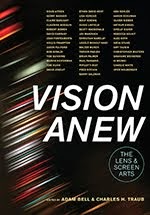
My review of Luigi Ghirri's Kodachrome (MACK, 2012) is now available on photo-eye. The books is a beautiful reprint of Ghirri's first major monograph. You can get a copy of the book here.
______________________________________
A pivotal photobook of the late 20th century, Luigi Ghirri's Kodachrome
was originally published in 1978 and is key to the history of European
and color photography. While Ghirri's work has received renewed
attention over the past several years, the witty, urbane and humanistic
photographs of Ghirri have largely been under-appreciated outside his
native Italy until now. Most recently, the photographer and artist
Thomas Demand has championed his work and included Ghirri in his
excellent exhibition La Carte d'apres Nature. Aperture's recent publication, It's Beautiful Here, Isn't It, was another welcome corrective. Long out-of-print, the new edition of Kodachrome will hopefully help restore and cement Ghirri's stature as a vital photographer of the 20th century.*

Ghirri's life was tragically cut shot when he died at the age of 49 in 1992. Well-respected in his native Italy, Ghirri not only built an impressive body of work, but also helped champion his colleagues and fellow Italian photographers. punto e virgola, Ghirri's publishing house, had a short run, but published Kodachrome, a few theoretical and academic books, a handful of books by Italian photographers like Franco Fontana and Roberto Salbitani, as well as monographs on other European and American photographers such as Dennis Stock and Robert Doisneau. Kodachrome was Ghirri's first monograph and collected images from his archive dating from 1971-78. This new reprint retains the design, size and modest paperback format of the first edition. The book includes Ghirri's original statement along with a short text by the architect Piero Berengo Gardin. Aside from a new essay by Francesco Zanot, which is included in a pamphlet insert that also contains French and German translations of all the book's texts, and new scans of Ghirri's slides, the book is unchanged.


The subjects of Ghirri's images are prosaic and drawn from the Italian landscape he inhabited and called home. His subjects include the beach, the blue sky of the Italian countryside, mirrors, windows, tourist sites, trompe-l'œil murals, parks and signs. However, the work's seemingly humble origins, modest size and muted colors belie their witty conceptual core. Through clever juxtapositions and visual puns, Ghirri's images constantly toys with the tension between reality and its representation. His work, in this book especially, is about the nature of pictures, seeing and the way we construct, imagine and view the world through and with images. As Francesco Zanot writes in the book's new essay, "his works are powerful devices for the re-education of the gaze." Never simple documents, the images frequent inclusion of signs, murals and photographs draws close attention to the constructive act of photographing. The photographs reveal their creation while at the same time toying with their artifice and the world they depict.

All images © Luigi Ghirri and MACK, 2012
Photography and art history is filled with neglected figures – artists whose work either came too soon, too late or fell on deaf ears. In an essay written in remembrance of Ghirri by his friend and photographer Charles Traub, Traub reflected on Ghirri's work and legacy. As Traub notes, "Ghirri's work stands significantly besides his better known American contemporaries, such as Stephen Shore, William Eggleston and Robert Adams." Traub goes on to write that "perhaps during the decade and a half when Ghirri worked, curatorial interests favored the detached dispassionate, cool eye rather than favoring wit…[His] concerns were post-modern before those words were bandied about in photographic circles."† Although Ghirri was not unrecognized in his lifetime, he was clearly out of step with prevailing American tastes and did not receive the attention her deserved. As this reprint demonstrates, his work not only continues to speak powerfully to the present, but more importantly, it also rejoices in the simple pleasures of seeing photographically.
*Photobook afficianados will also note that Kodachrome was also included in Parr and Badger's The Photobook, Vol. 1.
†Luigi Ghirri and Charles Traub, "Statement/A Remembrance," in The Education of a Photographer Ed. Steve Heller, Charles H. Traub and Adam Bell (Allworth Press, 2006), 125.
Please note: This review originally appeared on photo-eye on Jan. 3rd 2013. You get a copy of the book here.
Photography and art history is filled with neglected figures – artists whose work either came too soon, too late or fell on deaf ears. In an essay written in remembrance of Ghirri by his friend and photographer Charles Traub, Traub reflected on Ghirri's work and legacy. As Traub notes, "Ghirri's work stands significantly besides his better known American contemporaries, such as Stephen Shore, William Eggleston and Robert Adams." Traub goes on to write that "perhaps during the decade and a half when Ghirri worked, curatorial interests favored the detached dispassionate, cool eye rather than favoring wit…[His] concerns were post-modern before those words were bandied about in photographic circles."† Although Ghirri was not unrecognized in his lifetime, he was clearly out of step with prevailing American tastes and did not receive the attention her deserved. As this reprint demonstrates, his work not only continues to speak powerfully to the present, but more importantly, it also rejoices in the simple pleasures of seeing photographically.
*Photobook afficianados will also note that Kodachrome was also included in Parr and Badger's The Photobook, Vol. 1.
†Luigi Ghirri and Charles Traub, "Statement/A Remembrance," in The Education of a Photographer Ed. Steve Heller, Charles H. Traub and Adam Bell (Allworth Press, 2006), 125.
Please note: This review originally appeared on photo-eye on Jan. 3rd 2013. You get a copy of the book here.





